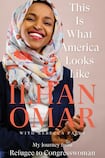
Just under a year ago Donald Trump took to the stage at a rally in Greenville, North Carolina. The combative president, who had swept to victory in 2016’s election in part by stoking up visceral rage against Hillary Clinton, had a new target.
Ilhan Omar, a congresswoman from Minnesota, “looks down with contempt on hard-working Americans”, supports al-Qaeda and is viciously anti-Semitic, he claimed. “Send her back, send her back,” yelled the crowd, as Trump paused and stood back, letting the tension build.
Omar, a 38-year-old Somali-born congresswoman, was one of dozens of women elected to Congress for the first time in the Democratic wave of 2018 – a mid-term election that was in part a reaction to the Trump presidency.
She is best-known as a member of the informal group known as the “Squad”, a quartet that also includes Alexandria Ocasio-Cortez of New York, Massachusetts’ Ayanna Pressley and Rashida Tlaib of Michigan – all women of colour who were elected to congress on an unapologetically progressive platform.
Omar is aware that she is defined as much by her opposition to Trump as by her own political beliefs and achievements. As she writes in her memoir, even before she decided to run for Congress she was being cast as the “face of the opposition” and held up as a “counternarrative to Donald Trump”.
Her book This Is What America Looks Like is an attempt to set out her own personal story and political rise, as it charts her journey from an African refugee camp to become the first American-Somali woman elected to congress.
Her story begins in Mogadishu, where she was raised in a loving, financially-comfortable family before war tore her world apart. As her home came under attack, the family fled in a cattle truck, eventually crossing the border into Kenya where she spent four years in a refugee camp. She was surrounded by death – “every week, somebody else died”, she writes after she lost her beloved aunt, who raised her after her own mother died when she was a toddler.
At the age of 12, her family was awarded a place on the much-coveted UNHCR resettlement programme and relocated to America.
Her initial impressions of the US would stay with her throughout her life. She describes seeing the rubbish piled up on the sidewalks in New York and the homeless people in Washington – a far cry from the images of smiling families living in houses with white picket fences she had watched on the orientation video in Nairobi. This initial insight into the social inequities of American society would shape her political consciousness and cement her deep commitment to left-wing causes.
Muslim ban
Mapping the family’s early years in Virginia and then on to Minnesota where there was a burgeoning Somali immigrant community, the book sketches Omar’s gradual immersion into American life. It describes the difficulties she faced as a teenager merging her Muslim faith with the cultural norms of her adopted country.
By the age of 19 she was married – “there was nowhere else for us to go if we wanted to stay together”, she says of her teenage boyfriend Ahmed Hirsi, also a Somali-American.
She enrolled in a two-year part-time course and had her first child. She recalls how, as her daughter learned how to crawl, news of the US invasion of Iraq played on the radio in the background. The challenges of being Muslim-American in the years after 9/11 were a constant.
As she settled into life, grappling with the financial challenges of raising a family and completing her education, she began volunteering at a local non-profit. This insight into the intersection between government-funded programmes and people’s lives, spurred an interest in grassroots politics.
By 2008 her marriage had broken down. She packed up the car and the children and relocated to North Dakota where she completed a four-year degree, rising at 4am to study before tending to the children. On her return to Minneapolis she threw herself into community activism and progressive politics.
Her first-hand experience of political campaigns would steel her for the conflict that was to await her in Washington. At one election caucus in 2014 she was physically attacked for supporting a young Somali candidate who was contesting a state seat held by another Somali long-time incumbent.
In 2016 she switched from political operative to politician, dislodging a 44-year incumbent to win a seat in the Minnesota state legislature. Shortly after, Trump was elected and her national profile soared.
After Trump announced his Muslim ban in February 2017 she held a press conference that garnered national and international attention. She appeared on late-night TV talk shows and made the front cover of Time magazine. Barely a year in the state legislature in Minneapolis, she decided to run for Congress in the 2018 midterms and won.
While Omar’s journey from Somali immigrant to become one of the first two Muslim women to serve in congress is inspiring, the book also touches on the troubles that accompanied her through life. Glimpses of an angry, anxious individual surface at times. “Fighting didn’t feel like a choice. It was a part of me,” she says as she recounts one of many occasions she was disciplined in school for physically fighting.
Later, there were bouts of intense physical and emotional strain – insomnia, weight loss, headaches – that culminated in what she describes as a “breakdown”, forced to confront the enormous trauma that she had suffered as a child.
She also addresses some of the conspiracy theories directed at her, particularly over her marriages. She confirms that the marriage to her first husband – who she briefly later reconciled with – was an Islamic marriage and had never been formalised by the state.
Ultimately, the book offers a moving account of a fierce, fearless woman who is ready to take her place in the halls of power and represent the kind of America – as the title of the book indicates – that Omar looks like.
In one anecdote she recalls the reaction of a Minnesota state senator when she ran for the leadership of their caucus. “I have never allowed myself to let anyone make me feel that I didn’t belong…I don’t have a fear of rejection. I was an equal member of the caucus, elected by the people, same as them,” she writes. “What did he expect? For me to walk around with an inferiority complex?”
As the demography of the United States moves away from the white homogenous identity Trump represents, Omar’s story offers hope to women, non-whites and other minorities everywhere that political representation is not just their right but can become a reality.
Suzanne Lynch is Washington Correspondent of The Irish Times










